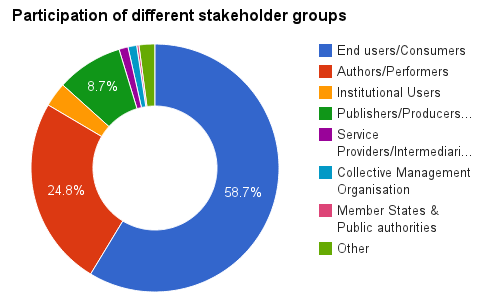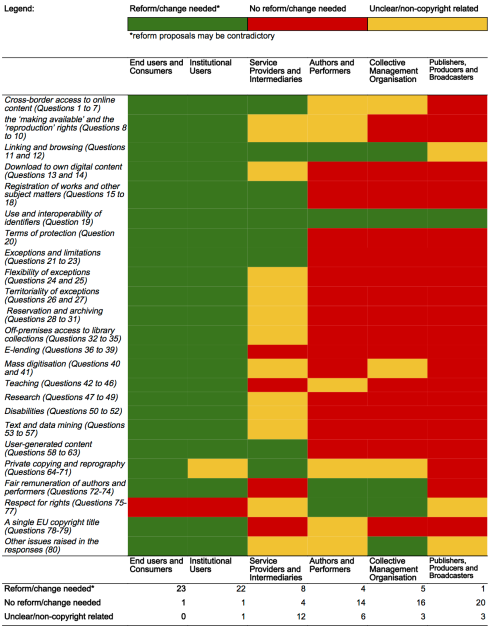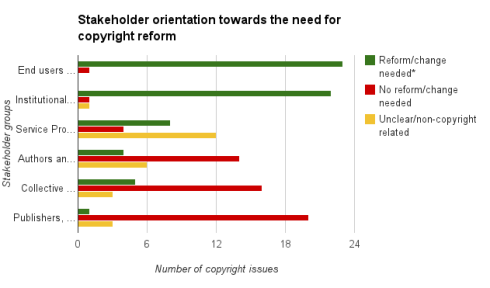This week the EU Commission published its report (PDF) on responses to the public consultation on EU copyright held earlier this year. The consultation had drawn a comparably high number of responses with a total of about 11,000 messages, not least due to initiatives such as fixcopyright.eu (targeting end users) and creatorsforeurope.eu (targeting authors and performers). While over at IPKat copyright buffs are already delving into the details of the report, I tried to have a look at the bigger picture here: what do we learn about the state of copyright at large? And what overall direction should copyright reform take? With regard to both questions the report is quite instructive because of its clear and straightforward structure.
The report is structured along the 80 questions of the consultation, which are distributed across 24 issue sections. Within each of these issue sections, the report distinguishes between the different stakeholder groups that took part in the consultation (see chart below).
What I have done is to check for each of the 24 issue sections whether one of the respective stakeholder groups sees a need for copyright reform or is content with the current copyright system (for details check out a public Google spreadsheet with original quotes). The results are not entirely surprising and very clear: we have a strong divide among copyright stakeholders with end users and institutional users (e.g. libraries, archives, universities) strongly in favor of copyright reform and authors, collective management organizations, publishers and producers in favor of the current copyright system.
As I see it, the two charts above indicate that current EU copyright is very unbalanced. When one side is completely satisfied with the status quo and the other is very unhappy then this is not a balanced situation. Given that a good compromise should leave everybody equally unhappy, the results of the consultation also show the direction for copyright reform efforts of the new EU Commission: re-balancing copyright requires at least some reform as demanded by end users and institutional users, most importantly a more harmonized and flexible system of exceptions and limitations.
The figures in this post and in the Google Spreadsheet are licensed under a Creative Commons Attribution International 4.0 license.
(leonhard)






10 comments
Comments feed for this article
July 31, 2014 at 15:18
Jest społeczny konflikt o prawa autorskie. Zobacz grafikę, która go opisuje | di24 new
[…] zwrócić uwagę na coś, co zrobił Leonhard Dobusch z Wolnego Uniwersytetu Berlina. Na blogu Governance Across Borders opublikował on grafikę, która mówi o tym, kto chce reformy w danym obszarze praw […]
November 11, 2014 at 16:01
Re-Balancing Copyright: Insights from the EU Consultation |
[…] in Europe”, November 11, 2014, in Brussels (see PDF of the program). It builds on an analysis of the European Commission’s report on on the responses to the Public Consultation on the Review of the EU Copyright […]
January 1, 2015 at 13:23
Blogging about Governance Across Borders: Statistics for 2014 |
[…] EU Commission’s Consultation Report Shows: Current Copyright is Unbalanced […]
January 20, 2015 at 18:28
Copyright for Creativity – A Manifesto for Change » infojustice
[…] Union should Support Innovation and Creativity through Copyright Reform’ tells a story. In an illustration of the results of the European Union’s (EU) 2014 consultation on copyright, publishers, authors and collective management organizations express strong support for the current […]
January 22, 2015 at 16:04
The Copyright Manifesto: How The EU Should Support Innovation And Creativity Through Copyright Reform
[…] Union should Support Innovation and Creativity through Copyright Reform’ tells a story. In an illustration of the results of the European Union’s (EU) 2014 consultation on copyright, publishers, authors and collective management organizations express strong support for the current […]
January 23, 2015 at 16:50
Europeana Professional - The road that leads to Copyright reform - Pro Blog
[…] agendas. In the meantime, the responses were rigorously reviewed by the wider IPR community notably an article by Leonhard Dobusch showing the imbalance of current copyright laws and Kennislands Paul Keller declaring […]
April 25, 2015 at 00:07
A Wikimedian asks European Parliament members for copyright reform « Wikimedia blog
[…] helped with similar documents. The consultation seemed to reach a dead end, as it proved that current laws are unbalanced but there was no energy to change their underlying […]
July 27, 2015 at 17:47
The Rhetoric of Copyright Extremism in European Copyright Reform Discourse |
[…] reading through the comments from conventional rightsholders to the questions on the EU Commission’s public consultation on copyright, one might think that we are already living in the best possible copyright environment. Aside from […]
July 28, 2015 at 06:52
Démonter la rhétorique des extrémistes du droit d’auteur | :: S.I.Lex ::
[…] lit les réponses des principaux titulaires de droits aux questions posées dans la consultation publique de la Commission européenne sur le droit d’auteur, on pourrait être tenté de penser que nous vivons déjà dans le meilleur des mondes possibles. […]
July 28, 2015 at 08:59
Démonter la rhétorique des extrémistes du droit d’auteur |
[…] lit les réponses des principaux titulaires de droits aux questions posées dans la consultation publique de la Commission européenne sur le droit d’auteur, on pourrait être tenté de penser que nous vivons déjà dans le meilleur des mondes possibles. […]